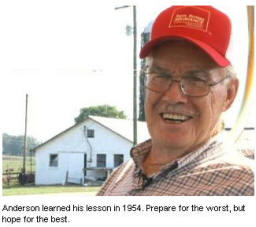A Navy man who traveled the world, Bob Anderson was never far away from his parents' Greenback farm for very long.
"I would come home on
leave and see how things were,"
For the first few years, he came home to heat.
"Those years from '51 to '54 were dry but not like '54. 1954 was the driest. It just didn't rain. Hot and dry," Anderson explained.
It got so hot and dry in 1954, cows had nothing to eat.
The Anderson's hay barn, usually filled with 600 square bales of hay, was empty. They and other farmers had to import it.
"They brought hay up to Greenback in railroad cars," Anderson said.
One topic focused conversation when neighbors ran into each other.
"Did you hear the weather
Anderson's father took a job in town, like many others, trying to make ends meet off the farm.
"We made it day by day," Anderson explained. "We didn't try to plan any because we didn't know what the future was, it was so dry."
Kind of like his grass this summer.
"The cows did have grass to eat but it was scarce," he said.
The difference this even-hotter year, Anderson learned his lesson in 1954. Prepare for the worst, but hope for the best.
"Sooner or later we expect another dry year. You never know. Maybe five years, maybe ten years," Anderson said. "Use your experiences from the last dry spell to help you through the next one. Prepare a little better, have a little more feed, never let your barns get empty."
Anderson was also around for the year that tops the list of 90 degree days -- 1936 -- but his memories are a little more vague.
He was four years old then.
